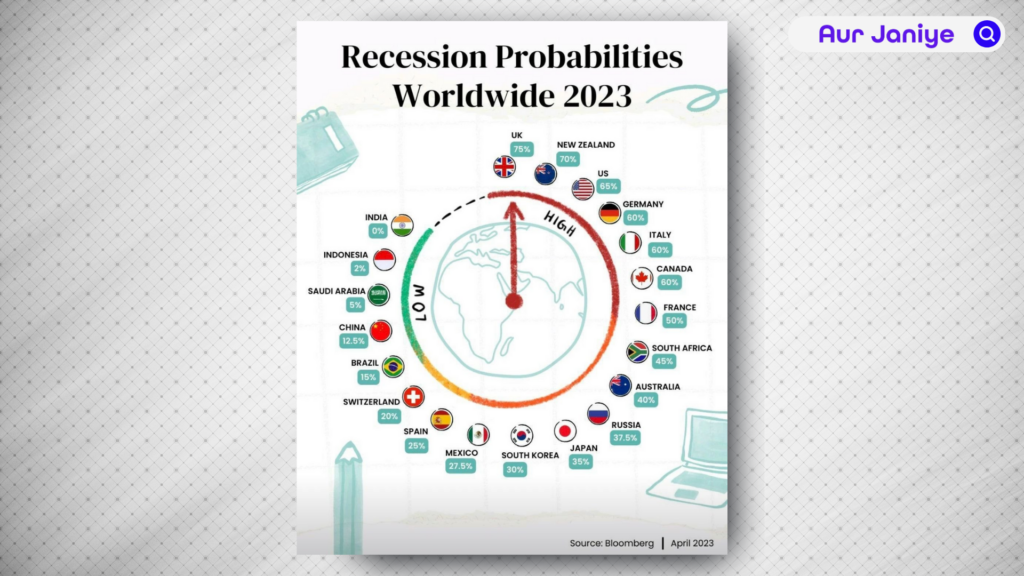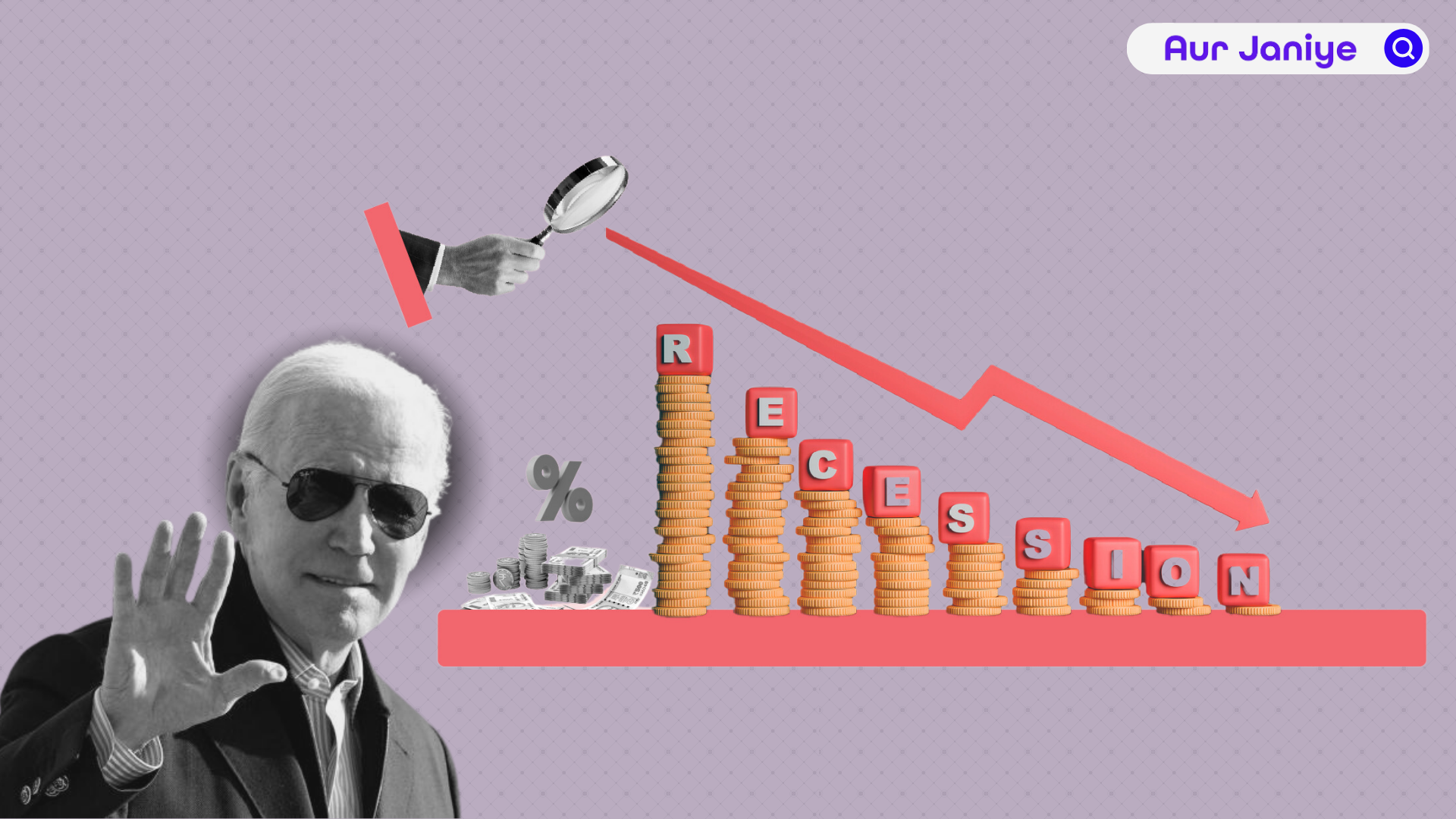When an economy is experiencing poor development and starts to contract, it is said to be in a recession. At least two quarters in a row of negative economic growth are required for its definition.
It is unclear whether this slow development must be observed on specific dates; it is just necessary that the economy contract for at least six months.
An economic depression can develop from a tiny initial economic decline, sometimes referred to as a “recession.”
What Is RECESSION? | Recession Definition in 2023
Economic Recession – This is quite akin to the “depression” phase; we might even term it a mild kind of depression. If not treated carefully and promptly, this could be catastrophic for economies. The financial crises that followed the US “sub-prime crisis” essentially brought about “severe recessionary” patterns throughout nearly the whole Euro-American economies. With the exception of point (iv) of the Depression, which was previously examined, the major characteristics of recession are, in large part, comparable to those of “depression” and can be summed up as follows:
- Demand declines broadly when economic activity slows down, inflation stays low or continues to show symptoms of declining, employment rates drop and unemployment rates rise, and industries move to “price reduction” to stay in business.
- The Indian economy experienced a cycle of recession in the financial year 1996–1997, primarily as a result of a general decline in both local and international demand, which was brought on by the
- Demand typically decreases as economic activity slows, inflation stays low or continues to show symptoms of slowing down, employment rates reduce and unemployment rates rise, and industries turn to “price reduction” to stay in business.
Cycle Of Recession In India | Background
In the financial year 1996-1997, the Indian economy went through a cycle of recession principally due to a broad fall in both domestic and foreign demand that was caused by the When economic activity slows down, inflation remains low or keeps exhibiting signs of slowing down, employment rates drop and unemployment rates rise, and industries resort to “price reduction” to stay in business, demand generally declines.
In the fiscal year 1996–1997, the Indian economy went through a cycle of recession mostly due to a general fall in.
Must Read The latest news – Russia Ukraine war (introduction, background, way forward)
The Great Depression Of 30’s Thirties
The mid-1990s South East Asian currency crisis. The entire plan for economic change in India was thwarted, and the economy wasn’t able to recover until the end of 2001–2002.
This Great depression was the longest and deepest downturn in the history of the United States and the modern industrial economy. The Great Depression began in August 1929, when the economic expansion of the Roaring Twenties came to an end. A series of financial crises punctuated the contraction.
What may a government do to rescue the economy from the phase of recession?
The standard treatments are listed below:
- Direct and indirect taxes should be reduced so that consumers’ disposable incomes (money remaining after paying direct tax, or income tax), on the one hand, and the cost of goods, on the other, will decrease.
- might pick up.
- The burden of direct taxes, especially the income tax, dividend tax, interest tax are slashed to enhance the disposable income (i.e., income after direct tax payment)—
- The government should alter salaries and wages to promote general consumer expenditure (as the Government of India swiftly adopted the fifth pay commission’s recommendations in 1996–1997).
- Reducing indirect taxes like sales tax, excise tax, and custom duty will enable goods to be produced at lower costs and enter the market.
- The government typically continues to pursue a low money supply policy by cutting interest rates across the board and liberalizing the lending process.
- Tax cuts for new investments in profitable sectors are announced, etc.
The United Front Government implemented all of the aforementioned steps in 1996–1997 to rescue the economy from the threat of the recession. By the end of 1998–1999 and moving forward, the new administration implemented numerous additional such policies (the NDA Government). In the end, the governments’ actions, along with a broad global economic recovery, allowed India’s economy to emerge from its period of recession. With zero inflation, many experts had long foreseen the prospect of a slump. Nevertheless, this did not occur.
Technically, both the World Bank and the IMF define recession. Any economy whose GDP declines for two straight quarters is
▷ Growth Recession
A term used by economists to characterise an economy that is expanding so slowly that there are more jobs being lost than being created. Even if the economy is still growing, the lack of employment growth gives the impression that a recession is taking place. Many analysts think that the US economy had a growth recession between 2002 and 2003. In fact, it is said that the American economy has gone through growth recessions on multiple occasions during the past 25 years. That is to say, despite increases in real GDP, employment growth was either nonexistent or was outpacing the creation of new positions.
Experts have brought this phrase back.
Also Read – Make a Business and know how to start a business in 50k
DUAL DIP RECESSION
In the USA and the Eurozone, the term “recession” has a very specific and technical definition: “two consecutive quarters of decreasing GDP.” Its extension is the notion of a “double-dip recession.”
A double-dip recession is when there is a recession, a brief rebound, and then another recession, with the GDP growth becoming negative after one or two quarters of positive growth. A decrease in demand for products and services as a result of forced job cuts and expenditure cuts made during the previous recession is frequently one of the reasons of such a recession. The worst-case scenario is a double-dip, which might even result in a “triple-dip” because of the dread and conjecture that it will happen.
gets too challenging. By the first quarter of 2013, there was concern of such a recession, as the world witnessed in the case of the Euro Zone crisis.
(See Glossary for information on “Retrocession”).
ARE WE IN A RECESSION?
Is America under the Recession?

India’s economy is still the fastest-growing in the world despite the global recession, and it will continue to grow for a very long time. As you can see from the image, Saudi Arabia, Indonesia, and India are the only nations with the lowest likelihood of experiencing a recession.
The likelihood of a recession in the United States is third greatest according to the above image. The United States is 65% likely to be in a recession. And very main reasons behind these downfalls are Debt, Banking Crisis in the US, and Russia-Ukraine war.
There are several indicators that the economy may be in recession.
- Inflation is at a 40-year high, with the Consumer Price Index (CPI) rising 8.6% by May 2022. This is driving Americans’ cost of living up dramatically and eating into their disposable income.
- The Federal Reserve raises interest rates to combat inflation. This could slow economic growth, as it would make it more expensive for businesses to borrow and invest.
- The stock market has been volatile in recent months, with the S&P 500 index down nearly 10% year-to-date. This is a sign that investors are worried about economic growth.
If the economy goes into recession, this will be the first time since the Great Recession of 2008-2009. A recession is defined as two consecutive quarters of negative GDP growth.
Here are some facts and figures about inflation in the United States:
- The Consumer Price Index (CPI) rose 8.6% in May 2022, the highest rate of inflation since 1981.
- The core CPI, which excludes food and energy prices, rose 6.0% in May 2022.
- The Producer Price Index (PPI), which measures the prices paid by businesses for goods and services, rose 10.8% in May 2022.
- The PPI for final demand, which excludes food and energy prices, rose 8.3% in May 2022.
us recession
According to Fed minutes, the US economy is projected to enter a recession in late 2023 as a result of the banking crisis.
The Federal Open Market Committee’s minutes from its meeting on March 21–22 reveal that after the failure of two regional banks last month, some officials at the US central bank discussed suspending interest rates.
BOTTOM LINE OF RECESSION
Basically, business cycles are shifts in an economy’s output levels above and below the trend of the equilibrium levels. But why do economies change throughout time? According to specialists, there are a variety of causes that might be to blame for it, including:
I Economic volatility and uncertainty (caused by reasonable or unreasonable expectations) may deter investment, slowing long-term growth.
(ii) The economy may experience a downturn or a decrease in total production if there isn’t enough creative destruction (also known as innovation).
(iii) Government anti-inflationary measures, particularly during general elections
